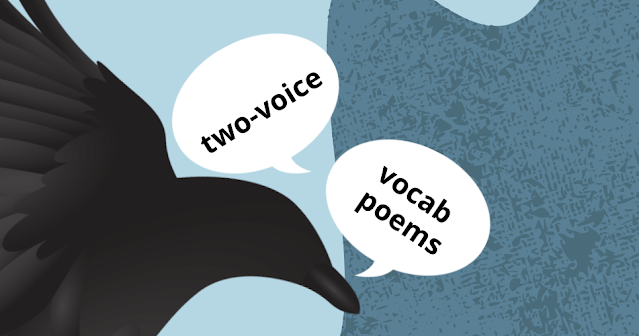Poetry + Vocabulary = Word Ownership
As I’ve noted in previous posts, students need repeated exposure to learn new words. Language and literacy expert Dr. Louisa Moats says that children need 10-12 encounters with a word in a variety of contexts before their truly learn the word. Dr. Catherine Snow of Harvard’s Graduate School of Education puts the number even higher at 15-20 encounters. In short, students need to return to words, reading, writing, and using them, again and again before they “own” them.
In addition, the standards require that students demonstrate understanding of the nuances in word meanings. A nuance is a very subtle difference. Words have shades of meanings, and students won’t understand those shades unless they practice using words in many different ways.
Writing poetry is a fun and accessible way for students to discover and apply those shades of meaning.
Two-Voice Poetry: Double the Vocabulary
One type of poetry that pairs well with vocabulary reinforcement is two-voice poetry. I’m a big fan of this form. (Which comes as no surprise if you read my previous posts: TWO-VOICE CHAT, TWO-VOICE POETRY READING, or A PLETHORA OF TWO-VOICE POEMS.)
As a reminder, a two-voice poem is:
written from two perspectives, showing two objects, creatures, or people in conversation
meant to be performed by two readers
often divided into columns
The left column, read by one performer, shows the first perspective.
The right column, read by another performer, shows the second perspective.
The middle column (often in bold font) shows ideas the two speakers share in common. It is read by both performers at the same time.
To warm students up to the concept of two-voice vocabulary poems, I ask for two volunteers to share this poem I wrote:
I ask students what they think “raucous” and “tranquil” might mean based on the poem. We discuss how two-voice vocabulary poems require the writer to “step into the shoes” of each word and image them in conversation.
Next, I model writing a two-voice vocabulary poem using words from students' vocabulary lists. I choose two words that are synonyms, antonyms, or share some other relationship. After reviewing the definitions of the words, I invite students to “step into the shoes” of each word and imagine what the words would say if they were alive. What actions would they take? How would they sound? What would the two words have in common? How would they be different?
When we’ve brainstormed a list of ideas, I review the format for two voice poetry. Then I model writing a two-voice poem, using this TWO-VOICE VOCABULARY TEMPLATE I designed:
Here is a poem two students created during a mixed-age poetry workshop I facilitated. They used words from my WORD BOWL. (See my post WORD BOWL POEMS for more ideas on how to use poetry to boost vocabulary.)
After I’ve modeled the form, I invite students to write their own two-voice vocabulary poems using words from a class vocabulary or their own personal word lists and the TWO-VOICE VOCABULARY TEMPLATE. I remind them that rhyming is optional, but good word choice is essential.
Writing two-voice vocabulary poems requires students to consider many connotations and examples of each word they’ve selected. This helps them discover nuances in meaning. As a bonus, it also reinforces concepts of personification, perspective, and comparing/contrasting.
Try writing two-voice vocabulary poems with your students. Display their finished poems gallery style around the room (or post them online using a program like Padlet.) Invite students to read their classmates' creations. Not only will your students enjoy the clever poetic conversations, but this serves as another exposure to vocabulary words in context. (For more vocab poetry fun, check out my VOCABu post, and try writing some vocabulary haiku.)
With two-voice vocabulary poems, your students will move one step closer to "owning" (and hopefully loving) new words!





Comments
Post a Comment